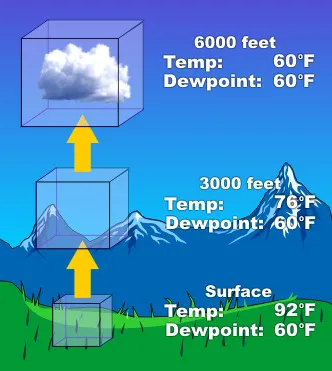Clouds and How They Form

As air rises it cools and decreases pressure, spreading out. Clouds form when the air cools below the dewpoint, and the air can not hold as much water vapor.
NOAA
Clouds are made of water droplets or ice crystals that are so small and light they are able to stay up in the air. But how does the water and ice that makes up clouds get into the sky? And why do different types of clouds form?
Water Vapor Evaporates Into the Air
The water and ice that make up clouds travels into the sky within air as water vapor, the gas form of water. Water vapor gets into air mainly by evaporation – some of the liquid water from the ocean, lakes, and rivers turns into water vapor and travels in the air. When air rises in the atmosphere it gets cooler and is under less pressure. When air cools, some of the water vapor condenses. As air pressure drops, some water vapor condenses too. The vapor becomes small water droplets and a cloud is formed.
Water Vapor Condenses to Form a Cloud
It’s easier for water vapor to condense into water droplets when it has a particle to condense upon. These particles, such as dust and pollen, are called condensation nuclei. Eventually, enough water vapor condenses on pieces of dust, pollen, and other condensation nuclei to form a cloud.
Clouds Form in Different Ways
Some clouds form as air warms up near the Earth's surface and rises. Heated by sunshine, the ground heats the air just above it. That warmed air starts to rise because, when warm, it is lighter and less dense than the air around it. As it rises, its pressure and temperature drop causing water vapor to condense. Eventually, enough moisture will condense out of the air to form a cloud. Several types of clouds form in this way including cumulus, cumulonimbus, mammatus, and stratocumulus clouds.
Some clouds, such as lenticular and stratus clouds, form when wind blows into the side of a mountain range or other terrain and is forced upward, higher in the atmosphere. This process can also happen without a dramatic mountain range, just when air travels over land that slopes upward and is forced to rise. The air cools as it rises, and eventually clouds form. Other types of clouds, such as cumulus clouds, can also form above mountains too as air is warmed at the ground and rises.
Clouds also form when air is forced upward at areas of low pressure. Winds meet at the center of a low-pressure system and have nowhere to go but up. All types of clouds are formed by these processes, especially altocumulus, altostratus, cirrocumulus, stratocumulus, and stratus clouds.
Weather fronts, where two large masses of air collide at the Earth’s surface, also form clouds by causing air to rise.
- At a warm front, where a warm air mass slides over a cold air mass, the warm air is pushed upward forming many different types of clouds, from low stratus clouds to midlevel altocumulus and altostratus clouds, to high cirrus, cirrocumulus and cirrostratus clouds. Clouds that produce rain like nimbostratus and cumulonimbus are also common at warm fronts.
- At a cold front, where heavy a cold air mass pushes a warm air mass upward, cumulous clouds are common. They often grow into cumulonimbus clouds, which produce thunderstorms. Nimbostratus, stratocumulus, and stratus clouds can also form at a cold front.
© 2019 UCAR with portions adapted from Windows to the Universe (© 2009 NESTA)